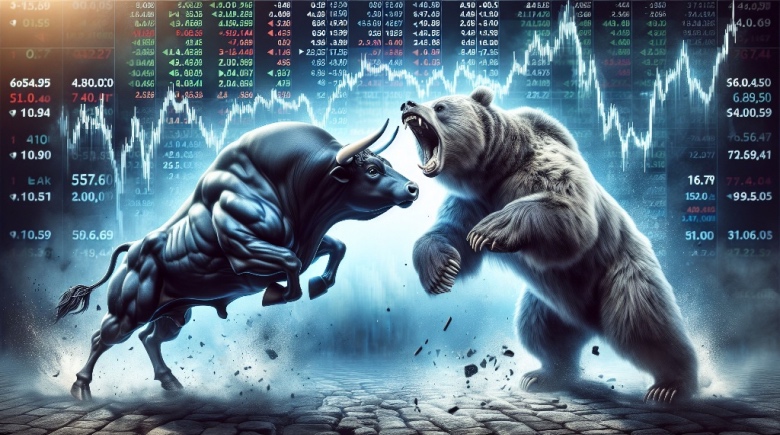Most Wall Street investors keep their fingers on the pulse of the Dow Jones Industrial Average (DJIA), the benchmark index widely considered to be a barometer for the stock market and the global economy. From January to June 2025, the DJIA was on a roller coaster track with a 52-week high of 45,073 and a low of 36,611; it rallied through February before dipping during March, plummeting in April, and recovering by May. This benchmark performance across two quarters represents volatility, an important aspect of financial markets that all investors should understand.
If your investing activities include stock trading, you must know that equity securities are among the most volatile assets in your portfolio. Shares of companies listed on the New York Stock Exchange and the Nasdaq are at the mercy of market trends that reflect investor sentiment. During the first half of 2025, the trends were shaped by geopolitical events and a chaotic White House. Volatility often develops when investors take market positions aligned with the “herd instinct” formed by interpretations of major news headlines.
How Trends and the Herd Instinct Generate Volatility
The herd instinct describes the trends investors follow when they rationalize the actions of a larger group. Instead of taking market positions based on market analysis, many investors are driven by psychological factors and Wall Street axioms. Perhaps you’ve heard the expression “Buy Low, Sell High,” which encapsulates the ultimate goal of all stock investors. There’s another Wall Street expression that many seasoned traders treat as a mantra: “The trend is your friend.” This suggests investors should align their strategies with the direction the market is taking, whether it’s moving upwards or downwards.
In a bearish market defined by widespread selling and declining stock prices, many investors close their positions and reduce their exposure to equity securities. When this happens, you can safely expect a collective shift of capital out of stocks and into perceived safe-haven assets like gold. We observed this in 2025 as the DJIA tumbled from 42,225 on April 2 to 37,645 on April 8; meanwhile, the price of gold at the Chicago Mercantile Exchange surged from $2,982 on April 7 to an all-time high of $3,424 on April 20. This behavior reinforces the downtrend in the stock market while simultaneously driving up the price of gold; it usually happens when investors follow the trend of seeking security outside of traditional equities.
Market Volatility and Investor Psychology
In the simplest breakdown of trading psychology, volatility occurs when investors are faced with a sudden dose of reality that deviates from their objectives, goals, and financial horizons. The volatility that characterized Wall Street from January to June 2025 was shaped by reactions to developments originating from the White House.
Looking back at January 10, the day that sparked the first major DJIA rally of 2025, investors were reacting to the prospect of a business-friendly presidential administration that would somehow reduce the federal budget deficit while cutting taxes for wealthy individuals and major corporations. This honeymoon-like market prevailed until late February; it was cut short by scandalous news headlines about the Department of Government Efficiency (DOGE) and the global trade war sparked by United States President Donald Trump.
The reality of the DOGE cuts and the import tariff conflict was reflected in the forecasts issued by market analysts and economists. The gloomy projections were not on the bingo cards of many Wall Street investors who had taken bullish positions, thus causing a market panic and a stock selloff. Reacting in panic is part of the Wall Street herd instinct, which is a hallmark of high-volatility periods.
When looking at the DJIA components and their exposure to DOGE cuts and tariffs risk, it is easier to understand the fears that prompted the selloff. Boeing and IBM are companies that rely on substantial contracts with federal agencies targeted by DOGE. Caterpillar and Walmart operate business models that are highly sensitive to import tariffs. Institutional investors like mutual funds and insurance companies tend to load their portfolios with DJIA stocks, and they quickly exit their positions when trouble looms.
How Investors Deal With Stock Market Volatility
Volatility is the opposite of stability; it can quickly move up or down based on how investors react. It can cause a market correction if a benchmark index pulls back by 10% or more. The DJIA went through a correction in April 2025; at the time, some Wall Street analysts warned that the index could fall deeper into bear market territory, which happens when benchmarks fall by 20%.
Some investors thrive during corrections and bearish markets by paying closer attention to financial trends and reading between the headlines. Short sellers, for example, take early positions as they speculate on how low the market will go. Day traders may “buy on the dip” or check technical analysis charts for mean reversion indicators. Value investors double down on financial statement analysis and look for stocks accidentally devalued by market volatility.
Throughout bullish or bearish periods, investors always find opportunities to derive profits. Short-selling, buying the dip, trading the trend, and reversing the mean are some of the most common strategies applied by savvy traders who don’t flinch when volatility strikes. The profit potential of volatile stock markets is limited by the risk/reward ratio; with this in mind, it is not something beginners should consider unless they have a solid grasp on the mechanics of market trends and volatility.
All investors should review financial news headlines relevant to their portfolios. If you prefer blue chip stocks like the DJIA components or S&P 500 companies, you should monitor all major Wall Street indices and how investors react to news headlines. If your risk/reward ratio keeps you out of the stock market during volatile periods, check out other asset classes such as bonds and commodities. Taking market positions is always risky, but it can be particularly dangerous during periods of higher volatility.
Most Wall Street investors keep their fingers on the pulse of the Dow Jones Industrial Average (DJIA), the benchmark index widely considered to be a barometer for the stock market and the global economy. From January to June 2025, the DJIA was on a roller coaster track with a 52-week high of 45,073 and a low of 36,611; it rallied through February before dipping during March, plummeting in April, and recovering by May. This benchmark performance across two quarters represents volatility, an important aspect of financial markets that all investors should understand.
If your investing activities include stock trading, you must know that equity securities are among the most volatile assets in your portfolio. Shares of companies listed on the New York Stock Exchange and the Nasdaq are at the mercy of market trends that reflect investor sentiment. During the first half of 2025, the trends were shaped by geopolitical events and a chaotic White House. Volatility often develops when investors take market positions aligned with the “herd instinct” formed by interpretations of major news headlines.
How Trends and the Herd Instinct Generate Volatility
The herd instinct describes the trends investors follow when they rationalize the actions of a larger group. Instead of taking market positions based on market analysis, many investors are driven by psychological factors and Wall Street axioms. Perhaps you’ve heard the expression “Buy Low, Sell High,” which encapsulates the ultimate goal of all stock investors. There’s another Wall Street expression that many seasoned traders treat as a mantra: “The trend is your friend.” This suggests investors should align their strategies with the direction the market is taking, whether it’s moving upwards or downwards.
In a bearish market defined by widespread selling and declining stock prices, many investors close their positions and reduce their exposure to equity securities. When this happens, you can safely expect a collective shift of capital out of stocks and into perceived safe-haven assets like gold. We observed this in 2025 as the DJIA tumbled from 42,225 on April 2 to 37,645 on April 8; meanwhile, the price of gold at the Chicago Mercantile Exchange surged from $2,982 on April 7 to an all-time high of $3,424 on April 20. This behavior reinforces the downtrend in the stock market while simultaneously driving up the price of gold; it usually happens when investors follow the trend of seeking security outside of traditional equities.
Market Volatility and Investor Psychology
In the simplest breakdown of trading psychology, volatility occurs when investors are faced with a sudden dose of reality that deviates from their objectives, goals, and financial horizons. The volatility that characterized Wall Street from January to June 2025 was shaped by reactions to developments originating from the White House.
Looking back at January 10, the day that sparked the first major DJIA rally of 2025, investors were reacting to the prospect of a business-friendly presidential administration that would somehow reduce the federal budget deficit while cutting taxes for wealthy individuals and major corporations. This honeymoon-like market prevailed until late February; it was cut short by scandalous news headlines about the Department of Government Efficiency (DOGE) and the global trade war sparked by United States President Donald Trump.
The reality of the DOGE cuts and the import tariff conflict was reflected in the forecasts issued by market analysts and economists. The gloomy projections were not on the bingo cards of many Wall Street investors who had taken bullish positions, thus causing a market panic and a stock selloff. Reacting in panic is part of the Wall Street herd instinct, which is a hallmark of high-volatility periods.
When looking at the DJIA components and their exposure to DOGE cuts and tariffs risk, it is easier to understand the fears that prompted the selloff. Boeing and IBM are companies that rely on substantial contracts with federal agencies targeted by DOGE. Caterpillar and Walmart operate business models that are highly sensitive to import tariffs. Institutional investors like mutual funds and insurance companies tend to load their portfolios with DJIA stocks, and they quickly exit their positions when trouble looms.
How Investors Deal With Stock Market Volatility
Volatility is the opposite of stability; it can quickly move up or down based on how investors react. It can cause a market correction if a benchmark index pulls back by 10% or more. The DJIA went through a correction in April 2025; at the time, some Wall Street analysts warned that the index could fall deeper into bear market territory, which happens when benchmarks fall by 20%.
Some investors thrive during corrections and bearish markets by paying closer attention to financial trends and reading between the headlines. Short sellers, for example, take early positions as they speculate on how low the market will go. Day traders may “buy on the dip” or check technical analysis charts for mean reversion indicators. Value investors double down on financial statement analysis and look for stocks accidentally devalued by market volatility.
Throughout bullish or bearish periods, investors always find opportunities to derive profits. Short-selling, buying the dip, trading the trend, and reversing the mean are some of the most common strategies applied by savvy traders who don’t flinch when volatility strikes. The profit potential of volatile stock markets is limited by the risk/reward ratio; with this in mind, it is not something beginners should consider unless they have a solid grasp on the mechanics of market trends and volatility.
All investors should review financial news headlines relevant to their portfolios. If you prefer blue chip stocks like the DJIA components or S&P 500 companies, you should monitor all major Wall Street indices and how investors react to news headlines. If your risk/reward ratio keeps you out of the stock market during volatile periods, check out other asset classes such as bonds and commodities. Taking market positions is always risky, but it can be particularly dangerous during periods of higher volatility.



